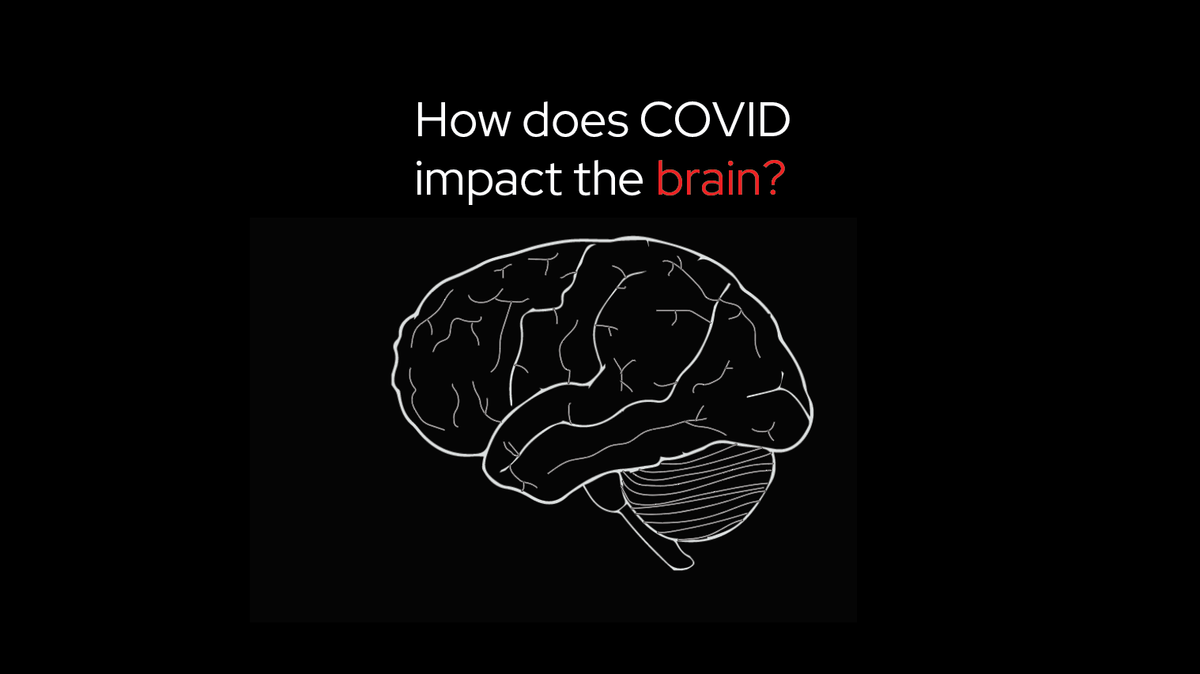How does COVID impact the brain?

Although COVID is primarily thought of as a respiratory disease, we’re learning that COVID’s impact extends well beyond the lungs. COVID infection can damage the heart, intestines, kidneys, and —perhaps most alarmingly— the brain. By causing blood to clot more easily, COVID can trigger major clotting events like strokes, which lead to serious brain damage. But that’s not the whole story — COVID can also impair brain function in ways we don’t fully understand yet. Many people (even those who were not hospitalized) report new neurological symptoms after COVID infection, such as brain fog, memory loss, difficulty concentrating, and even psychiatric issues like depression and psychosis. These symptoms can last months or even years after testing negative.
Many people develop new neurological and psychiatric issues after having COVID
In a study of more than 200,000 COVID patients, approximately 13% of patients received their first neurological diagnosis after COVID infection. That percentage jumps to almost 26% in COVID patients who were hospitalized. This suggests that while patients with more severe COVID are more likely to develop new neurological issues, the likelihood is still alarmingly high in patients who are not hospitalized. Catching COVID increases your risk of debilitating neurological issues, even if you don’t end up in the hospital.
Long-term neurological symptoms are part of “long COVID,” which occurs when symptoms persist for more than a month after an initial COVID infection. Long COVID impacts many parts of the body (not just the brain) and can cause a wide range of symptoms including intense fatigue, difficulty breathing, trouble concentrating, chest pain, insomnia, memory problems, and mood disorders. Long COVID is unfortunately quite common: one study that tracked people with COVID infections found that 30% went on to develop long COVID, including many who were not hospitalized from their COVID infection. While not everyone who develops long COVID will experience neurological symptoms, these symptoms are commonly reported. These are unsettling odds, especially given how little we know about long COVID and how COVID affects the brain.
What causes the neurological symptoms of COVID?
If COVID can cause all these neurological problems, you would think that the virus finds its way into the brain. At first, this is what most scientists thought, but other theories are emerging as more research comes in. As of now, we don’t know for certain whether neurological symptoms are due to the virus entering the brain or more widespread effects of infection.
Loss of smell: our first clue that COVID impacts the nervous system
COVID patients losing their sense of smell was one of the first indicators that COVID could affect the nervous system. Because our sense of taste relies heavily on scent, losing the ability to smell often means losing the ability to taste too. As a result, loss of smell can make even your favorite meal taste horribly bland. Initially, scientists interpreted the loss of smell in COVID patients as a sign that COVID reaches the brain by infecting the neurons in the nose. However, it turns out this may not be the case.
To infect a cell, the virus must bind a specific receptor on the cell that allows the virus to enter, like a key fitting into a lock. Although many brain cells have the receptors for SARS-CoV-2, the neurons in the nose don’t, which suggests that the virus can’t enter the brain by infecting these neurons. Instead, the virus might infect different types of cells in the nose, setting off a chain reaction that indirectly impacts the neurons that control smell. Whether the virus can enter the brain via other neurons that pass between the nose and the brain is still up for debate.
Does SARS-CoV-2 enter the brain during infection?
An alternative theory is that SARS-CoV-2 accesses the brain through the bloodstream. The brain is protected from viruses in the bloodstream by the blood brain barrier, or BBB for short, which acts like a protective fence between blood vessels and brain tissue. Only certain types of cells can get through the BBB, but some viruses can hitch a ride on those cells to sneak across and get into the brain. SARS-CoV-2 might enter the brain that way, or the body’s immune response to COVID could weaken the BBB, allowing the virus to break through.
Surprisingly given the range of neurological symptoms, there is relatively little virus present in the brain after COVID infection. In a study of 41 COVID patients, researchers detected low to nonexistent levels of virus in the brain. Furthermore, they found no association between the level of virus in the brain and the presence of neurological symptoms. This suggests that rather than directly attacking the brain, COVID might affect the entire body in ways that ripple outward. If this is the case, then systemic inflammation and a lack of adequate blood flow to the brain could cause the neurological symptoms of COVID rather than direct infection of neurons.
Blood clots and inflammation may explain COVID’s impact on the brain
Inflammation is part of the body’s defense response against injury or illness. While unpleasant to experience, inflammation is usually beneficial because it protects your body from damage. But when inflammation gets too severe or attacks healthy tissue, that can be serious cause for concern. For reasons that we don’t fully understand, COVID damages the lining of the blood vessels and makes blood clot more easily than normal. This combination of widespread inflammation, blood vessel damage, and blood clots leads to disruption of blood flow, impairing the delivery of oxygen and nutrients to the cells that need them. In COVID patients, this disruption of blood flow may be happening not only in small blood vessels in the brain but also throughout the body, which could explain the widespread symptoms of long COVID.
Changes in the brain after COVID infection
Regardless of how COVID exerts its effects, it has been linked to significant changes in brain structure. A recent study compared the brain scans of 401 people before and after COVID infection with the brain scans of 384 people who were never infected. The researchers found that people infected with COVID had a greater reduction in brain size over time compared to people who were not infected. Before panicking about shrunken brains, keep in mind that the study doesn’t include whether these individuals were vaccinated, which variant they were infected with, or how severe each person’s disease was. Any of these factors could potentially influence the changes observed, and future studies are needed to connect the dots.
Another method for observing the effects of COVID on the brain is using postmortem studies, or studies of brain tissue after death. The most common findings in the brains of COVID patients are signs of inflammation, such as the activation of cells that serve as the clean-up crew of the brain, sweeping up debris from dying cells. Many brains also have damage caused by a lack of oxygen and bleeding from ruptured blood vessels.
What do these results actually tell us?
As with any research findings, it’s important to consider the limitations of the methods to accurately interpret results. Postmortem studies tell us what the brain looks like at the time of death. They do not tell us what happened to the brain in the months or weeks leading up to death or whether the brain abnormalities actually caused disease symptoms. As a result, one of the limitations of postmortem studies is the inability to determine cause and effect. Just because the brains of COVID patients often have signs of damage doesn’t mean that these signs caused the neurological symptoms of COVID; it just means that they were present at the same time. Another factor, such as widespread inflammation, could have caused the symptoms, and the brain damage might be a secondary effect. In addition, only fatal cases are examined – you can’t extract the brain of a living patient – meaning postmortem studies are biased towards the most severe cases of a disease. So, taking all this into account, what do these studies tell us? Some COVID patients have significant brain changes and even brain damage after infection, likely due in part to inflammation and inadequate blood flow.
In conclusion, there is substantial evidence linking COVID infection to impaired brain function, but there is still a lot we don’t know about how COVID affects the brain. The virus has been found in some brains but not all, and we don’t know whether the virus causes symptoms by attacking the brain directly or triggering widespread inflammation and blood vessel damage. The intersection of COVID and the brain is an area of active study, and as more information is published, we will have a better understanding of the long-term consequences of COVID infection on brain health and function. One thing is clear though: even if COVID doesn’t hospitalize someone, it can still cause long-term, debilitating health issues.
Sarah Donofrio is a contributing writer for You Can Know Things. She is pursuing a Ph.D. in Neuroscience studying the role of neurodegeneration in movement disorders, and is particularly interested in how the cerebellum contributes to motor dysfunction in disease and normal aging.
The views expressed on this website do not necessarily reflect the official views of the author’s employers or affiliated institutions. This post is for informational purposes only and is not meant to substitute medical advice from a qualified health professional.




